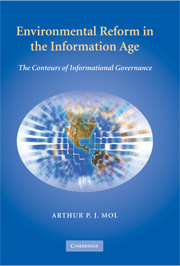Book contents
- Frontmatter
- Contents
- Tables, figures and boxes
- Preface
- Introduction: new frontiers of environmental governance
- Part I Theory
- Part II Praxis
- 5 Monitoring, surveillance and empowerment
- 6 Environmental state and information politics
- 7 Greening the networked economy
- 8 Environmental activism and advocacy
- 9 Media monopolies, digital democracy, cultural clashes
- 10 Information-poor environments: Asian tigers
- Part III Conclusion
- References
- Index
5 - Monitoring, surveillance and empowerment
Published online by Cambridge University Press: 03 November 2009
- Frontmatter
- Contents
- Tables, figures and boxes
- Preface
- Introduction: new frontiers of environmental governance
- Part I Theory
- Part II Praxis
- 5 Monitoring, surveillance and empowerment
- 6 Environmental state and information politics
- 7 Greening the networked economy
- 8 Environmental activism and advocacy
- 9 Media monopolies, digital democracy, cultural clashes
- 10 Information-poor environments: Asian tigers
- Part III Conclusion
- References
- Index
Summary
Our analysis of actual changes in environmental governance under new informational conditions starts with processes of environmental monitoring and information collection. This chapter focuses primarily on environmental monitoring, and the following chapters are dedicated to the use of such informational resources in governance (although, as we will see, a very strict separation is not really possible). After introducing conventional ideas and modes of environmental monitoring, attention will turn to informational innovations in monitoring and the new questions that come to the fore: questions on informational power through enhanced monitoring capacities, questions of surveillance that come along with informational power and the enhanced possibilities of countersurveillance by citizen-consumers.
Conventional environmental monitoring
Traditionally, nation-states and national environmental authorities have been given the task and responsibilities for collecting, handling and disseminating environmental information. This task has always been connected to the collective good character of the environment. Initially, states took the initiative to set up nationwide environmental monitoring programs, consisting of three main parts. First, states were central in measuring environmental quality of, among others, surface water, ground water and drinking water; of (especially outdoor) air quality; of pollution levels of soil (on agricultural land, industrial areas, waste dumps, and so on); and of the quality of nature reserves and parks, biodiversity and ecosystems. Second, national and local environmental authorities played a central role in collecting information on various emissions and factors that influenced environmental quality.
- Type
- Chapter
- Information
- Environmental Reform in the Information AgeThe Contours of Informational Governance, pp. 107 - 131Publisher: Cambridge University PressPrint publication year: 2008



